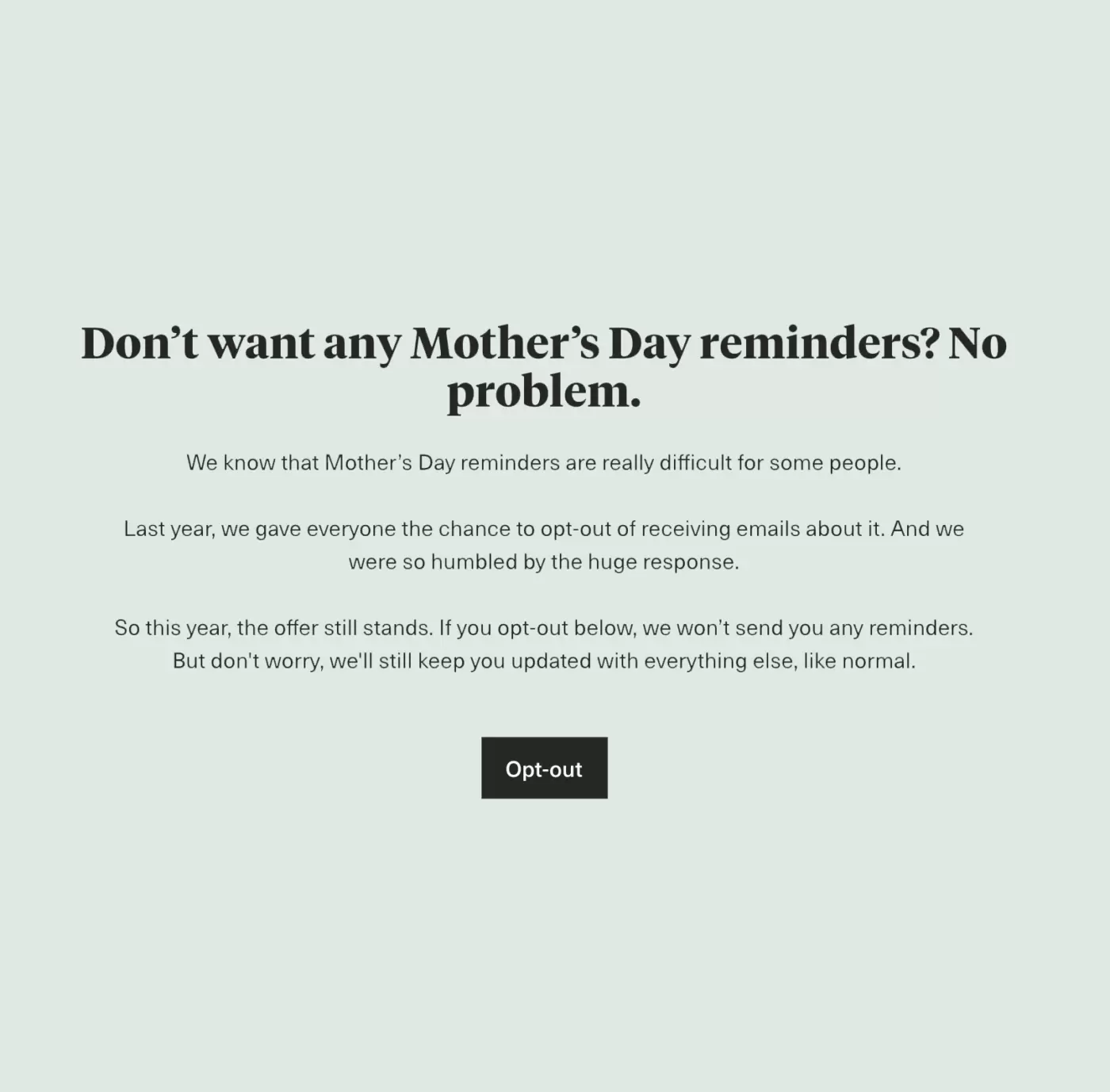Want 10% off your order? Join Club Holly & Co

What is ‘Thoughtful Marketing’?
Brand & Purpose
With Charlotte Langley, from Bloom & Wild
UPDATED 5TH JULY 2023
Ever wondered how you could be a bit more thoughtful in your business’ approach to marketing? With thanks to our floral friends at Bloom & Wild, in this article we explain how it all starts with listening to your customer and bringing emotion to your brand. Discover more…

Connecting with your customers: the power of thoughtful marketing
‘Thoughtful Marketing’ puts the customer’s needs front and centre, and through this acknowledgement, it keeps the customer coming back. Sounds simple, but for so many companies, as the demands of starting up and keeping things going take priority, connecting with the customer can easily fall to the bottom of the list.
The pioneering flower company, Bloom & Wild (whose founder Aron Gelbard you can hear on our Conversations of Inspiration podcast), is practically a household name now, but it started with what was a small but completely original idea — bouquets that fit through the letterbox. The team there has always championed Thoughtful Marketing (and even coined the phrase). So how did it start? It started with their #CareWildly campaign.
The brand sells flowers, but they discovered that at the heart of why people send bouquets is essentially because they care. It’s the intangible, emotional element of the product that customers buy into — and ultimately that’s what keeps them connected to the brand. Bloom & Wild realised this and decided to take a more thoughtful approach to help them ‘care wildly’.
Tips from the experts at Bloom & Wild: thoughtful marketing pioneers
Back in 2020, Holly spoke to Charlotte Langley, who was then the Brand & Communications Director at Bloom & Wild. Despite the business growing at scale (and increasing their offering), they’d managed to stay in touch with what their customer wanted, even several years on. She told us that it can be as simple as making time to ask a question via social media or email, and why this is so important (and on this subject, read Gord Ray’s top tips on using Instagram for business too).
Charlotte called these questions ‘pointy’ questions. She recommended asking just one very focused one such as, “What is the single thing that you love most about our brand?” or ‘What is the single thing you’d love to think more about?” This gives you tangible feedback which you can act on quickly, rather than asking big, broad questions which may be difficult to understand. Keep it simple, you don’t need to create sprawling surveys (which, unless someone is a superfan, may put the customer off anyway). It can be easier than you think. This is how Bloom & Wild proved their theory that not everyone wants a dozen red roses for Valentine’s Day…
Thoughtful Marketing puts the customer’s needs front and centre, and through this acknowledgement, it keeps the customer coming back.
What do customers really want? Asking customers the right questions
One Valentine’s Day, Bloom & Wild wanted to make sure they were giving customers what they really wanted. They asked the ‘pointy’ question of how people felt about red roses and found that nearly 80% of people would prefer something else on 14th February. This is something that, Charlotte said, the brand had initially felt a bit scared about sharing (understandably), but now they had conclusive evidence directly from the customer.
The conversation initially came up on Instagram, which Charlotte viewed as being the easiest way to emotionally connect and interact with customers. As a platform, it’s great for imagery which means it’s perfect for sharing inspiration and encouraging people to shop. But what about other social media? Twitter is also good for conversations with customers but is less visual (for Bloom & Wild, they use this platform to share their customers’ experiences). Facebook helps for building your community. Remember that you don’t have to use them all, but they each have a benefit and should be used differently (so avoid posting the same content across all your platforms ideally).
Learning from your customer: listening to customer feedback
The other way that Bloom & Wild has consistently stayed in touch with their customer is through their Customer Delight Team, who regularly shared their insights with the Marketing Team. One of these insights, for example, was that a number of customers had asked not to receive emails around Mother’s Day because it was triggering for them. The team realised that something bigger was going on here: not only did they need to offer the ability to opt out of certain emails, but also, there was an opportunity for thoughtful marketing to take hold. And it did — Bloom & Wild created the Thoughtful Marketing Movement, with its own web page on the site, and you can find out more about the community there.

It’s got to be truthful, it’s got to be authentic, you’ve got to be able to deliver on it if you are going to have an emotional conversation with people.

A few years on and ‘opt out’ emails have become the ‘norm’ for many commerce brands, but Bloom & Wild pioneered this approach from the start. Connecting in a thoughtful way can be fantastically effective. But as Charlotte pointed out, “It’s got to be truthful, it’s got to be authentic, you’ve got to be able to deliver on it if you are going to have an emotional conversation with people.” It can’t simply be a strapline with no follow-through. By expressing that authenticity, you create greater trust with your core audience who will likely be repeat customers.
Remember that if you have a tight budget, an emotional connection with your key customer can nurture loyalty. Build your business on an ethos that the customer strongly identifies with, and they are buying into all of that too, which means you have an audience that is understanding of the prices you charge. Then you come full circle to those brand ambassadors who spread the good word about your work near and far. It’s a win-win for everyone, which is why Thoughtful Marketing works.
Thoughtful Marketing: key takeaways…
Building a positive perception of your business results in brand loyalty — and the best place to start is through listening to your customer. Implement some of these pointers, and you’re well on your way to embedding a Thoughtful Marketing approach into your brand…
1. Dedicate time every week to listen to your customer:
Read reviews (the good and the bad), take note of what people are saying about you and action what you can from their feedback.
2. Remember the small things:
The best way to create a lasting, positive experience for your customer is through the little things and keeping it human (like how Bloom & Wild add a ‘Shh, your flowers are sleeping’ sticker to every box) — don’t forget the details. They make people smile.
3. Focus on one thing that’s important to you as a brand, and also for your customers:
For Bloom & Wild, they champion ‘care’ (as everything about flower gifting is driven by this, so caring is at the heart of everything they do). Doing one thing really well will attract your super fans.
Images: ‘Letterbox Flowers’ — by Bloom & Wild, 'Smiley Heart Card' — by Cut & Make, Thoughtful Marketing message — by Bloom & Wild, 'Kindness Is The Best Currency' screen print — By Basil & Ford
Related content
MORE ARTICLES ON BRAND & PURPOSE

Brands of the future and anticipating future trends
Brand & Purpose

You are your brand — stand out!
Brand & Purpose

The value of brand; why it’s your most important asset
Brand & Purpose

What makes good brand advertising?
Brand & Purpose

Why B Corp businesses and brands that do good are the future
Brand & Purpose

The art of creating a magical brand experience
Brand & Purpose

The secret to building a brand
Brand & Purpose

How to create a brilliant brand (& why it matters)
Brand & Purpose
Be the first to know
Sign up to our emails for brand new small business magic and inspiration. And if you create an account, you’ll also get exclusive product drops, discounts and more from Club Holly & Co, too.
